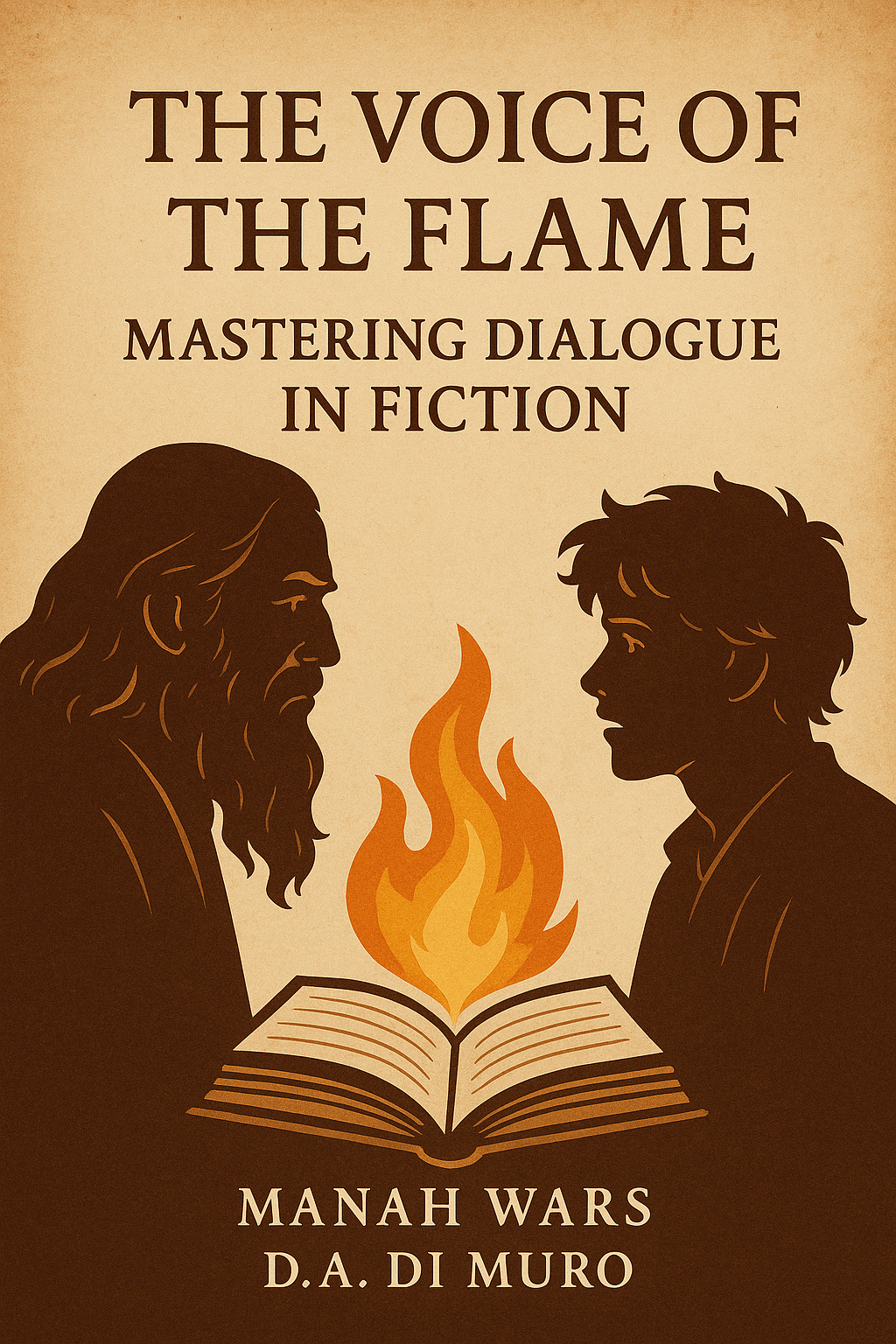The Voice of the Flame: Mastering Dialogue in Fiction

The Voice of the Flame: Mastering Dialogue in Fiction
“Dialogue is not just what is said — it is what is risked.”
— D.A. Di Muro, Manah Wars
Dialogue is the heartbeat of fiction. It breathes life into characters, forges emotional bonds, and unveils the hidden pulse of a world. In Manah Wars, dialogue is not mere chatter—it is a crucible of loyalty, betrayal, revelation, and myth. In this post, we explore how to harness dialogue as a transformative tool, grounding our insights in the saga of Manah Wars, the classics of literature, and the enduring truths of character and voice.
1. The Basics of Dialogue
Dialogue, like manah, flows through a story's veins. Just as Aedan’s conversations with Grandor reveal more than what is said—hinting at secrets buried in the Royal Library—so too must your dialogue adhere to a structural rhythm. Quotation marks frame the spoken word; tags like he said, she whispered, and they murmured ensure clarity. Action beats (e.g., “Grandor stroked his beard,”) create pacing and reveal the physical world around the words.
Read Fitzgerald’s The Great Gatsby or Le Guin’s Earthsea to see how clean formatting frames powerful conversation. Like the glow worms in the Mhan Royal Library, it's the structure that lets the light shine.
2. Show, Don’t Tell
“You are not the eldest. You are not the heir. Show some respect and back off!”
— Kainan, Manah Wars
When Queen Maya arrests Aedan for defiance, we do not simply know she’s furious—we feel it in her cutting tone and the cold silence between her words. Dialogue should show emotion without labeling it. “He was angry” becomes “His fists clenched around the reins. ‘You think this is justice?’ he spat.”
Compare this to Hemingway’s Iceberg Theory — what is said is the tip; what is felt lies beneath. Let your characters' reactions, interruptions, and omissions show us the storm beneath the still water.
3. Establishing Character Voice
From General Uriah’s gravel-throated protests to Shun’s quiet surveillance, each character in Manah Wars speaks with a unique cadence that reflects their worldview and history. A well-crafted voice instantly tells us who is speaking, even without a tag.
Tolkien’s characters speak in elevated, archaic tongues; Cormac McCarthy strips dialogue bare. Manah Wars strikes a balance—Grandor’s wise restraint contrasts with Aedan’s raw, youthful passion. When writing, build your characters’ vocabulary and rhythm out of their past, their class, and their dreams.
4. Subtext and Implication
Subtext gives dialogue its soul. Consider the scene in the Manah Wars where Aedan and Maya exchange barbed words about reclaiming Thule. Though Aedan seems compliant, the layers of mistrust, history, and ambition simmer beneath every sentence.
In real life, we often say one thing and mean another. Let your characters lie, deflect, or go silent. A forced smile can say more than a tirade. This technique recalls the masterful tension in Pinter or Chekhov, where silence is a character in its own right.
5. Advancing the Plot
Dialogue should do more than fill space—it should move the world. In Manah Wars, when Aedan demands access to the Royal Library, it triggers not just a plot shift but a moral one. That single request alters the kingdom’s future and leads to his incarceration.
Every conversation should change something: a decision, an alliance, a mood. Like Frodo and Boromir’s fateful talk by the river in The Lord of the Rings, a powerful exchange can pivot the entire narrative.
6. Naturalistic vs. Stylized Dialogue
On the pirate ship The Red Head, Gautarians bark insults and poetry in the same breath. Their slang and aggression feel visceral and real. In contrast, when Relianstar speaks, her words echo with celestial weight and mysticism.
Great writers like Shakespeare use stylized dialogue to elevate moments; Zadie Smith captures everyday cadence. Decide what serves your scene: the rough growl of truth or the lyrical hum of fate. But remember—authenticity is key, whether your character is a queen or a gutter thief.
7. Dialogue Tags and Beats
Don’t let “he said” do all the work. Let your beats reveal character. When Aedan breaks into the Royal Library, the careful click of his lockpick and the silent way he moves through the dust tell us everything about his intent and stakes.
Use beats to show movement, mood, and momentum. Let your characters sip tea, wince, shift their weight—show their inner storm with physicality. Avoid adverbial overload (e.g., he said angrily) unless the adverb offers unexpected insight.
8. Revision and Refinement
Like the forging of a Roj’ah blade, great dialogue is honed over time. Read it aloud. If it stumbles, cut it. If it soars, strengthen it. Let each line ring with truth.
Compare your drafts to the polished exchanges in Manah Wars or Game of Thrones. Dialogue must balance art and authenticity. In your revisions, ask: is this what they would really say, or just what I want them to say?
9. Conclusion: The Voice Beyond the Words
“You will never have me, Kainan. And with your attitude, you will never have anyone.”
— Ferni, Manah Wars
That single line cuts deeper than any blade. It reminds us: dialogue is not just sound—it's consequence. Let your characters bleed, grow, fail, and ascend through their words.
In Manah Wars: Glimmer in the Darkness, dialogue is a ritual—a channel through which manah flows. And in your own writing, it can be just as powerful.
So the next time you write, ask yourself not just what your character says—but what they risk by saying it.
Further Reading
-
Manah Wars: Glimmer in the Darkness by D.A. Di Muro – Purchase Here | Library Listings (Auburn, Lidcombe)
-
On Dialogue by Robert McKee – an in-depth look at crafting compelling exchanges.
-
Writing Fiction: A Guide to Narrative Craft by Janet Burroway – a foundational text on literary technique.
